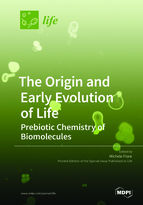The Origin and Early Evolution of Life: Prebiotic Chemistry of Biomolecules
A special issue of Life (ISSN 2075-1729). This special issue belongs to the section "Origin of Life".
Deadline for manuscript submissions: closed (31 May 2019) | Viewed by 114305
Special Issue Editor
Interests: systems chemistry; systems biology; prebiotic chemistry and prebiotic systems chemistry; origin of life; prebiotic synthesis of amphiphiles; total synthesis of racemic and enantiopure phospholipids; evolvable molecular systems synthesis of fluorescent clickable probes; synthesis and application of glycolipids; radical reactions
Special Issues, Collections and Topics in MDPI journals
Special Issue Information
Dear Colleagues,
What is life? How, where, and when did life arise? These questions have remained most-fascinating over the last hundred years. It is a common opinion, in accord with the words of David Deamer, that “life can emerge where physics and chemistry intersect”. However, this sentence do not exclude biology, astrophysics, geochemistry, geophysics, planetology, earth science, bioinformatics, complexity theory, mathematics and philosophy from the equation. From an evolutionary chemical point of view, is possible to presume that life emerged from a mixture of inanimate matter: Organic and inorganic compounds. Such compounds reacted under favorable conditions, forming molecules that are commonly called “biotic” and that, thanks to a kind of self-organization, gave rise to the first biopolymers and to proto-metabolisms.
This Special Issue has the ultimate aim to summarize the latest discoveries regarding the chemical origins of biotic molecules. Although astrochemical evolution has only been able to give rise to very simple chemical compounds, only the pioneering experiment of Miller (and related experiments) has proven that it is possible to form some of the most relevant biotic bricks fromsimple inorganic compounds In recent years, dozens of excellent reviews and articles appeared in the literature and some breakthroughs have already been achieved. However, a great dealof work remains to be done. I am deeply convinced that, beyond the borders of the traditional domains of scientific activity, the multidisciplinary character of the present Special Issue leaves space for anyone to creatively contribute to any aspect of these and related relevant topics. We hope that the presented works will be stimulating for a new generation of scientists that are taking their first steps in this fascinating field. Submission of original reserach, scientific perspectives and literature reviews on this topic are deeply encouraged.
Dr. Michele Fiore
Guest Editor
Manuscript Submission Information
Manuscripts should be submitted online at www.mdpi.com by registering and logging in to this website. Once you are registered, click here to go to the submission form. Manuscripts can be submitted until the deadline. All submissions that pass pre-check are peer-reviewed. Accepted papers will be published continuously in the journal (as soon as accepted) and will be listed together on the special issue website. Research articles, review articles as well as short communications are invited. For planned papers, a title and short abstract (about 100 words) can be sent to the Editorial Office for announcement on this website.
Submitted manuscripts should not have been published previously, nor be under consideration for publication elsewhere (except conference proceedings papers). All manuscripts are thoroughly refereed through a single-blind peer-review process. A guide for authors and other relevant information for submission of manuscripts is available on the Instructions for Authors page. Life is an international peer-reviewed open access monthly journal published by MDPI.
Please visit the Instructions for Authors page before submitting a manuscript. The Article Processing Charge (APC) for publication in this open access journal is 2600 CHF (Swiss Francs). Submitted papers should be well formatted and use good English. Authors may use MDPI's English editing service prior to publication or during author revisions.
Keywords
- Prebiotic chemistry
- Origin of life
- Prebiotic molecules
- Amphiphiles
- Dynamic chemical complexity
- Evolvable molecular systems
- Protocells
- Proto-metabolims
- Energy storage
- Chemical evolution







